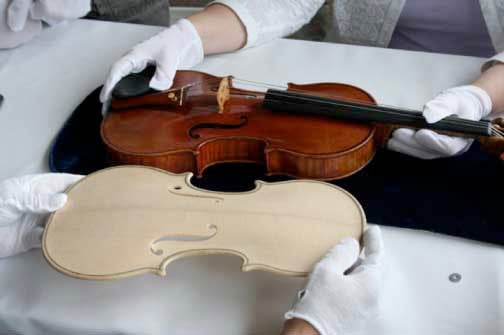
Posted on 11/30/2011 8:48:15 PM PST by afraidfortherepublic
CAD, CNC kit used to knock out wood
Attempts to recreate the renowned Stradivarius violin continued this week with boffins proposing an all-new approach using CAT scans and CAD software.
After studying the anatomy of several instruments using a computerised axial tomography (CAT) scanner, Mora, Minnesota-based radiologist Steven Sirr managed to get hold of a Stradivarius, borrowed from the US Library of Congress, to scan.
Along with two instrument makers, Sirr set about creating replicas of Antonio Stradivari's highly-sought violins.
More than 1000 CAT scans were taken of the instrument, all of which were analysed and converted into 3D computer-aided design (CAD) models.
These were then fed into a CNC machine, which was used to carve the various body pieces from different woods, picked to match the density of the original.
The team has so far assembled and varnished three full replicas, which members say sound "amazingly similar to originals in their sound quality".
Their findings were presented to the Radiological Society of North America. You can read more about the process there.
With some Stradivarius violins fetching over £10m in auction houses, the search for a cheaper, yet equally impressive alternative has been a Holy Grail quest for instrument manufacturers and classical music buffs.
A few years ago, a retired university professor claimed to have successfully reverse-engineered a Stradivarius by burning wood samples and analysing the the smoke. ®

fiddlesticks!
Talkin about you!
Great idea!
Cool.
Burned samples from what? A Stradivarius? How can that be?
Somehow I have a funny feeling that all these efforts will continue to fail.
Maybe they have some ruined samples that can be sacrificed... that’s all I can think.
I’d bet it makes little difference what they were finished with, and more difference what the ultimate dimensions (including the thicknesses) are. Sometimes violin makers find that the unfinished instrument sounds better in testing, but they can’t leave them that way as the wood would deteriorate.
Doesn't sound a lot like failure to me. Brute force technology (the only way they could have done this in the past would have been to sacrificially disassemble a Strad) looks like it has won the day.
I want one!
Now they’ve reverse engineered the dimensions, it probably won’t be long until China is turning out fiberglass versions at $25 a pop. Another mystery down the drain....
When my mother died I was given my grandfather’s ‘fiddle.’ I was honored as his playing, though I never heard it, was the stuff of family legend. After I got the violin home I looked inside it. When I saw the label ‘Stradivarius’ I thought I had won the lottery. Unfortunately a few minutes on the Internet revealed that hundreds, if not thousands, of knockoff Strads were made in the 20s and 30s. The fact that it was kept in an old flour sack should have been my first clue.
Somehow I expect that even the modern efforts, with all their technology will discover that it is not possible to replicate a Stradivarius. But you cannot blame them for trying.
Kind of amazed at the fact that the library of congress has one.
They keep it in Warehouse 13 with the Ark of the Covenant.
They will be all over eBay at 99 cents + $129 shipping...
****I’d bet it makes little difference what they were finished with, and more difference what the ultimate dimensions (including the thicknesses) are****
The finish on acoustic instruments has a significant part to play(no pun intended...ok it was intended)in the final sound of an instrument. For example, a clear finish and a satin finish will make identical models sound different(less brightness for the silk finish).
Between the finish and the age of the original Stradivarius, it will be difficult to match the sound even with correct dimensions and woods. Also the sound of those Strads has changed over the years, so nobody alive today really knows what a contemporary instrument really sounded like.
Of course these are small differences and not very noticeable to most people, but the players can easily tell.
I wonder what it cost to do 1000 CAT scans? How much do hospitals charge for 1000 CAT scans?
I suspect it was 1000 slices of a single CAT scan.
Satin and clear are mainly optical effects. Unless the stiffness was different or the thickness, a blind test shouldn’t know the difference.
Disclaimer: Opinions posted on Free Republic are those of the individual posters and do not necessarily represent the opinion of Free Republic or its management. All materials posted herein are protected by copyright law and the exemption for fair use of copyrighted works.